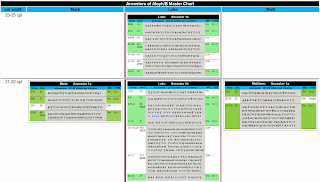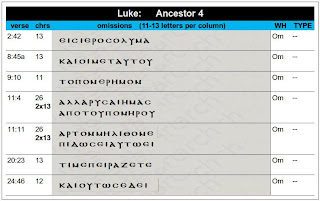Often the Hortians raise the issue of why there seem to be few Byzantine MSS for the whole period between the 4th and 9th centuries.
Not only is it suggested that the origin of the Byzantine text-type itself should be bumped centuries later commonly supposed, but that its dominance, even its very existence ought to be questioned, right up to the 8th century.
Recently,
a whole new theory, or rather conjecture, has been proposed, in which two previously unheard of "
recensions" have supposedly taken place, one in the
9th, and one in the
11th century. This anonymous idea is to be based on a seemingly unavailable "doctoral thesis" by one
Timothy Ralston from DTS.
 |
| Dr. Ralston |
|
|
The alleged 'evidence' of these new recensions is supposed to be found in examining 9th and 11th century MSS themselves, and proposing a timeline and readings belonging to each of these two centuries, then contrasting them to the
TR. The fact that the standard readings of the Majority text go back to the 5th century and earlier is apparently no barrier to the argument that these readings could have merely floated about, apparently unattached to a "text-type" until adopted by official editors very late in the game.
Our own alternate theory is that having come from the Great White North, Ontario Canada, Dr. Ralston's brain may still be partially frozen, somewhat like the "Ice-Age Man", and need more thawing out before he should attempt constructing a history of the Byzantine text.
The Real Explanation
Another, more practical expert,
Dr. Maurice Robinson, has kindly cataloged for us
the extant NT manuscripts by century. This allows us to plot the quantities now known, against the expected numbers and shape of curve for a normal copying process:
 |
| Click to Enlarge |
The result is a surprising discovery: The actual "curve" has a huge 'bite' out of it. This disturbing result can be centered on a specific era or span of centuries:
 |
| Click to Enlarge |
|
|
To get a grip on why this is so unusual, and what it means, we need to review briefly how things actually
should work.
An Analysis of MS Transmission
For this purpose, we can put aside questions of text, and just talk about physical numbers of MSS, and the process that generates them. MS generation can be modeled along the lines of a simple 'stock market' system. That is, its a basic process with a small amount of positive feedback, allowing for a limited 'runaway growth'. This is a classic Fibonacci series, like rabbit population growth.
The graph here shows net MS production: the new MSS made, minus the number of MSS worn out or destroyed. There is potential for 'negative growth' for short bursts, when production can't keep up with destruction. Most of the time however, production will outstrip losses.
In this case, over shorter periods MS production capacity will be relatively constant, controlled by the # of production centers and resources. Regulating Factors will include seasonal harvests (for papyri), scheduled slaughtering (for parchment), and available scribes.
One effect of constant capacity over short periods will be that fluctuations in production (as a % of total MSS) will gradually diminish as the total numbers of
MSS increase.
 |
| click to enlarge |
|
|
Just as in the simple Stock Market model, short term fluctuations and instabilities are absorbed and averaged out by longer term trends, in our case the steady increase in the total number of MSS.
In the long term however, the number of production centers and the quantity of MSS produced will increase alongside the expanding Christian population.
This is a simple 'market driven' process, of supply and demand, limited by opportunity and resource management, and periodically affected by outside uncontrolled forces, like drought, short bursts of persecution, discovery of production centers or caches of MSS, and killing of key skilled personnel such as copyists. However, these short-term instabilities in production and catastrophic bursts of MSS destruction will have a typical 'stock-market' morphology. Recently, scientists have analyzed the stock-market in terms of
Catastrophe Theory and similar models, in order to spot signs of instability and predict follow-up trends.
For our purposes, the point of interest is the tell-tale 'Saw-Tooth' shape of the market plot. Whenever there is a local short-term burst of instability in the model (which could be either production failure or destruction of MSS in our case), a Saw Tooth fingerprint will appear in the long-term trend plot:
 |
| Click to Enlarge |
|
|
What is important to realize is that the typical kinds of 'catastrophe' have a distinct shape, which is determined by the nature of the feedback mechanisms of the model. It is not arbitrary but predetermined by the 'market' forces. In our even simpler case,
deviations from this pattern of overall steady exponential growth are very difficult to produce.
Back to the Problem of the 'Big Bite'
Lets look again at the hole in the expected exponential growth curve:
This can only imply one of two basic situations. Either,
(1) MSS were systematically and universally destroyed over a long period, from about 400 A.D. to about 900 A.D., or else,
(2) The MSS were all selected at the end of this period (about 900 A.D.) and selectively destroyed by age-range as the criterion. In this case, it would be a conscious, perpetrated and massive act of vandalism.
Since there was no selection made based upon the content or text-type, but rather age alone,
it could not have been a deliberate act of forced 'recension' or revision, with the non-conforming MSS being destroyed. Although there is a natural and gradual increase in the percentage of MSS containing key readings (like the
Pericope de Adultera, Jn 7:53-8:11), this is just what we would expect in a natural,
unguided and unselective destruction of MSS independent of their textual affinities or content.
The idea of two late, official 'recensions' (9th and 11th century) is a fantasy that contradicts the textual data regarding variants and their century by century support. For instance, we have shown that a check of the surviving manuscripts with
John 7:53-8:11, shows a
gradual increase in the percentage of MSS that contain the verses (see our simple
chart of MSS with the PA).
But the problem of the missing manuscripts remains to be explained:
Dr. Maurice Robinson is painfully aware of this problem, and must conjecture a wholesale 'procedure' that involves recopying
and DESTROYING the exemplars. This is to account for the existance of a huge number of manuscripts from all over the empire from the 9th, 10th, 11th, 12th, 13th, centuries onward,
while there are virtually no surviving MSS for the previous 5 centuries.
A handful (less than a few hundred Greek uncials and fragments) simply won't adequately cover this relatively recent period. The gradual dominance of Latin for instance, would only account for lower numbers of Greek MSS
later on, not earlier. But if there was a 'destruction process' operating over 5 centuries, it would explain the handful of survivors, that escaped.
But a sudden catastrophe or policy of destruction, if it came at the very end of the 8th century would have prevented the massive quantities that survived immediately afterward. Such a relatively instantaneous process would have left two marks in history:
(1) A record of the catastrophe, in the form of a protest and historical evidence.
(2) A dearth of MSS to use as masters, and a long-lasting shortage of MSS of all ages afterward.
The answer seems to be in a much simpler problem and solution, uniquely attached to the Eastern Byzantine Empire:
A lack of quantities of good vellum and parchment resulted in a strategy of re-scraping, recycling, and reusing worn out manuscripts, giving their pages a second 'life', by a fresh recopying of the texts in a new form.
Such an explanation accounts for the repeated problems of war, famine, and disease which interfered with vellum and parchment production. It simultaneously accounts for the undocumented 'destruction' (a mere habit of recycling because vellum was precious).
It also accounts for the surprising number of palimpsests and hidden uncial texts underlying minuscule MSS.
If such a practice of recycling was widespread, as a result of ever-increasing demands for vellum in a world where ever-increasing production was simply unsustainable, another expected symptom and glaring fact is explained.
The peak of the "Golden Age" of the Church was not the 9th, 10th, or 11th century, but rather the 4th, 5th and 6th.
Where are all the wonderful works of the prolific early fathers, commentators, debaters of the most productive and creative period the Church has ever experienced?
The same problem and the same answer await us. The vellum was sorely needed to produce more copies of the Gospels, for an ever-expanding Church, and we strongly suspect that secular writings, the writings of the early church fathers, government documents, and anything else that used up precious vellum and took up needless space would have been cannibalized to meet the needs of New Testament manuscript production, on a "most useless first" basis.
It is probable that the some 10,000 Latin copies of the Gospels hide palimpsests of hundreds or even thousands of Uncial Greek copies and other documents, no longer of the same value or use in an Empire that was losing the ability to converse in Greek, as the Greek-speaking world rapidly contracted from war and the winds of change.
Peace
Nazaroo






























